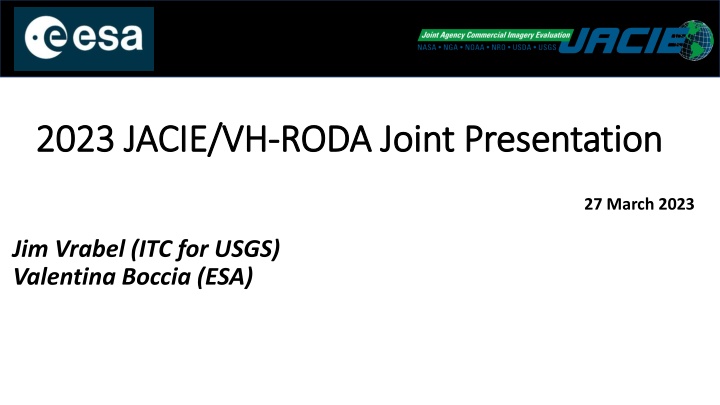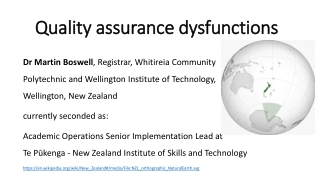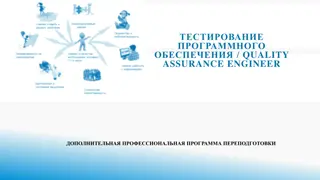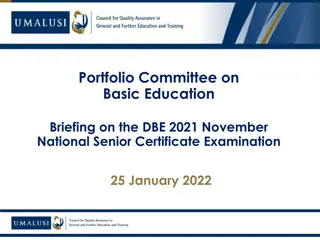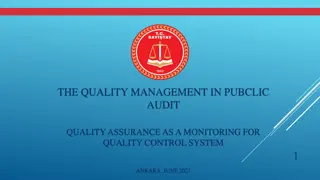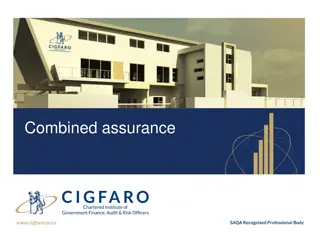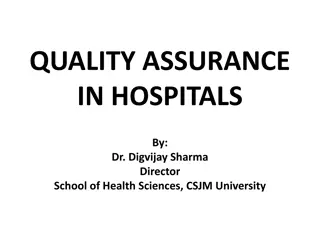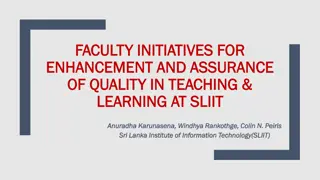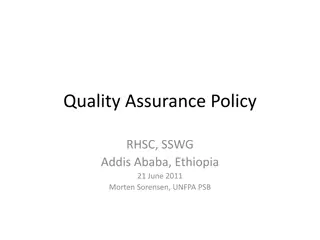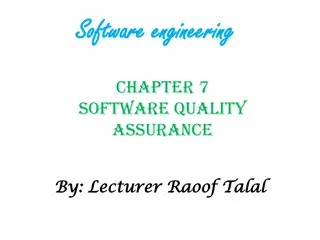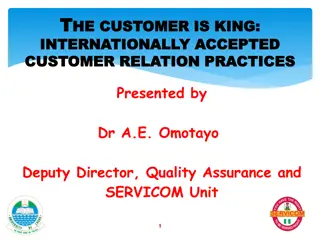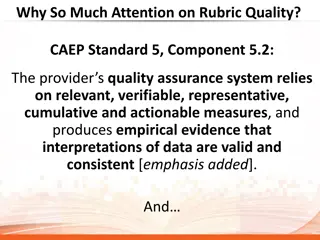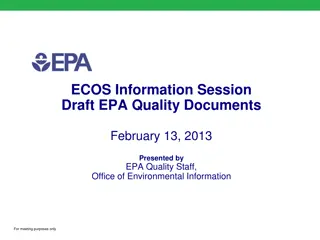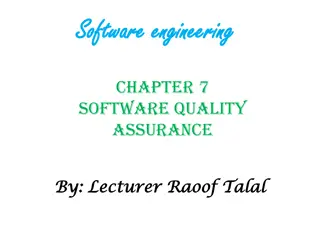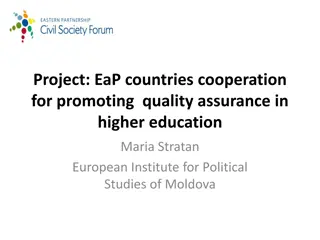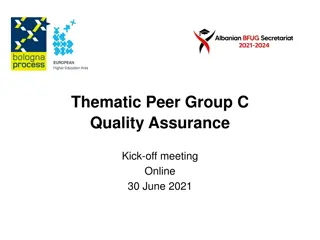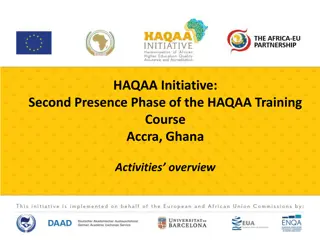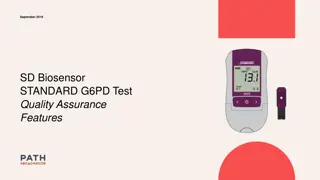Collaboration Efforts in Earth Data Assessment and Quality Assurance
The joint presentation between JACIE/VH and RODA highlighted the importance of linking workshops each year and pursuing collaborative actions. Key focus areas include system characterization best practices, maturity matrix development, and coordination between agencies for image quality assurance processes. Regular meetings and future plans for coordination with ESA and VH-RODA were also discussed to enhance data assessment efforts.
Download Presentation

Please find below an Image/Link to download the presentation.
The content on the website is provided AS IS for your information and personal use only. It may not be sold, licensed, or shared on other websites without obtaining consent from the author.If you encounter any issues during the download, it is possible that the publisher has removed the file from their server.
You are allowed to download the files provided on this website for personal or commercial use, subject to the condition that they are used lawfully. All files are the property of their respective owners.
The content on the website is provided AS IS for your information and personal use only. It may not be sold, licensed, or shared on other websites without obtaining consent from the author.
E N D
Presentation Transcript
2023 JACIE/VH 2023 JACIE/VH- -RODA Joint Presentation RODA Joint Presentation 27 March 2023 Jim Vrabel (ITC for USGS) Valentina Boccia (ESA)
Background First JACIE/VH-RODA joint presentation occurred at 2022 VH-RODA workshop Joint JACIE/VH-RODA presentation focused on actions to link workshops each year This will be done at each JACIE and VH-RODA workshop JACIE plans on being represented at future VH-RODA workshops to ensure continued work on actions items and other collaboration Pursue actions from each of the workshop at the subsequent workshop JACIE Workshop Ideas Learned from VH-RODA VH-RODA was very useful in helping to identify topics/briefers for the annual JACIE Workshop VH-RODA also helped with identifying other ways to improve the JACIE Workshop U.S. Geological Survey
Image Quality/Assurance Process Coordination Currently ESA is working on an Earth Data Assessment Project (EDAP) and developing a Cal/Val Maturity Matrix NASA and ESA already collaborate in this area Other JACIE partners are interested in understanding these efforts and the potential to adopt portions or all of this framework and its methods JACIE to explore adopting this or an analogous process USGS has looked at what boxes in the matrix we can populate (e.g., geolocation accuracy, radiometric accuracy, spatial accuracy) USGS is exploring including the Maturity Matrix in our system characterization process USGS and NASA have talked about coordination on future assessments using the maturity matrix and future USGS-NASA meetings are planned Need to be consistent with using the maturity matrix and bring together processes of NASA and JACIE agencies Determine which boxes each agency fills Hold subsequent meetings with ESA JACIE Best Practices document JACIE has a Best Practices doc for system characterization in final draft At some future date it would be good to have ESA participation in the JACIE Best Practices document In the future we plan to explore incorporating the EDAP Best Practices and the Maturity Matrix into the JACIE Best Practices Doc Document HS process and other processes (e.g., SAR) USGS working HS assessments already, but need to document all processes USGS has an interest on extending assessments to SAR in the near future U.S. Geological Survey
Other VH-RODA/JACIE Coordination Regular meetings scheduled between USGS/JACIE and ESA/VH-RODA management Include other JACIE agencies in future meetings Online JACIE Remote Sensing Satellite Compendium Explore future USGS-ESA coordination on Compendium and ESA Earth Online Ground Control Points (GCPs) If any JACIE organizations have GCPs that can be shared with ESA please contact me JACIE Clearinghouse website page for assessments and data All JACIE agencies support this idea USGS and NASA to work on it ESA involvement also? ESA invited to JACIE monthly Technical Team meetings Future ESA TT presentation(s) would be welcome ESA invited to JACIE Management Team Coordination meetings ARD 2023 Workshop coordination (May 2023) U.S. Geological Survey
VH-RODA & JACIE Coordination We have started an active coordination between JACIE and VH-RODA since VH-RODA's 1st edition (i.e. 2019). We've had coordination meetings between the JACIE and VH-RODA teams since 2019, with the goal of: identifying together the main challenges and needs at the international level in the optical EO domain (e.g. cal/val methodologies, data quality, ARD, etc.); addressing them at both JACIE and VH-RODA events so to continue and facilitate the discussions throughout the year and with all the scientific community (independently from the geographical area - US and Europe); coordinating with the time frame when to host JACIE and VH-RODA, so to make sure that there is a balanced time difference between the two and discussions can continue throughout the entire year. U.S. Geological Survey ESA / VH-RODA representation at each JACIE workshop since 2018, so to ensure and strengthen cooperation.
VH-RODA & JACIE Coordination Next Steps . Continuing shared support for addressing the actions and recommendations taken at VH-RODA and JACIE (e.g. GCPs database) "it would be good to have ESA participation in the JACIE Best Practices document" ESA is willing to contribute to the JACIE Best Practices document "USGS has an interest on extending assessments to SAR in the near future" At VH-RODA we've been addressing the SAR domain since the VH-RODA 1st edition. Also, we've been performing assessments of SAR missions since already a few years now. Therefore, ESA can support USGS / JACIE team with extending assessments to SAR. U.S. Geological Survey
Way Forward VH-RODA and JACIE represent important forums and give voice to the international EO community Common focus areas and continuity of discussions with the other relevant international workshops and forums: o JACIE (Joint Agency Commercial Imagery Evaluation) workshop o ARD (Analysis Ready Data) workshop o CEOS (Committee on Earth Observation Satellites) JACIE now, ARD in May 2023, and VH-RODA in November 2023 will continue to push ideas and improvements toward next JACIE in 2024 What you provide in this JACIE workshop will drive the future we need your input and involvement >>>> U.S. Geological Survey
